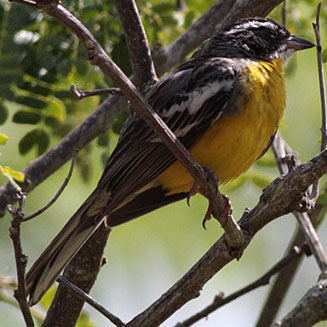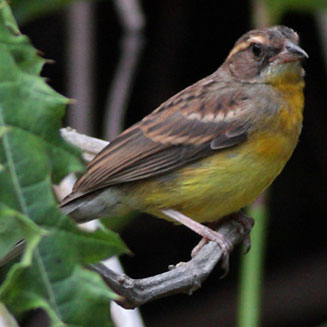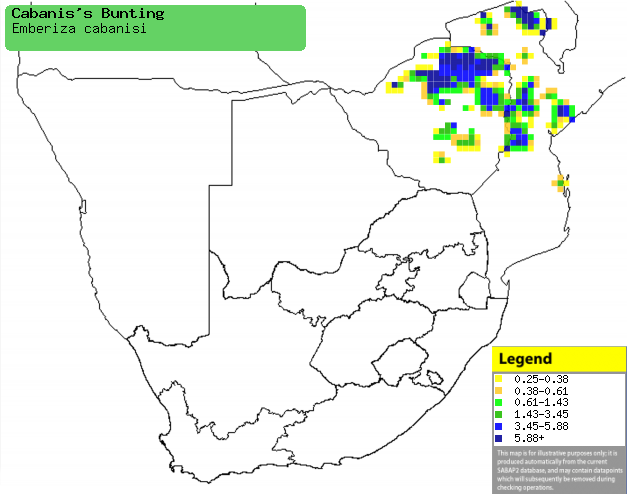|
Emberiza cabanisi (Cabanis's
bunting)
Geelstreepkoppie [Afrikaans]; Cabanis-gors [Dutch]; Bruant
de Cabanis [French]; Cabanisammer [German]; Escrevedeira de Cabanis [Portuguese]
Life
> Eukaryotes >
Opisthokonta
> Metazoa (animals) >
Bilateria >
Deuterostomia > Chordata >
Craniata > Vertebrata (vertebrates) > Gnathostomata (jawed
vertebrates) > Teleostomi (teleost fish) > Osteichthyes (bony fish) > Class:
Sarcopterygii (lobe-finned
fish) > Stegocephalia (terrestrial
vertebrates) > Tetrapoda
(four-legged vertebrates) > Reptiliomorpha > Amniota >
Reptilia (reptiles) >
Romeriida > Diapsida > Archosauromorpha > Archosauria >
Dinosauria
(dinosaurs) > Saurischia > Theropoda (bipedal predatory dinosaurs) >
Coelurosauria > Maniraptora > Aves
(birds) >
Order: Passeriformes > Family: Fringillidae
 |
 |
|
Cabanis's bunting male (left) and female (right),
Tanzania. [photo Martin Goodey
©] |
Distribution and habitat
Occurs in patches across sub-Saharan Africa, from Sierra
Leone to Uganda south through Tanzania, Zambia and Angola to southern Africa.
Here it is generally uncommon and localised in north and central Zimbabwe and
Mozambique, generally preferring miombo (Brachystegia) woodland with
little or no undergrowth.
|
 |
|
Distribution of Cabanis's bunting in southern Africa,
based on statistical smoothing of the records from first SA Bird Atlas
Project (©
Animal Demography unit, University of
Cape Town; smoothing by Birgit Erni and Francesca Little). Colours range
from dark blue (most common) through to yellow (least common). |
Food
It mainly eats seeds and insects, doing most of its
foraging on the ground, sometimes alongside other birds in a mixed-species
foraging flock. The following food items have been recorded
in its diet:
Breeding
- Monogamous solitary nester, building a deep cup of twigs, roots, grass,
leaves and weed stems, lined with rootlets and fine grass. It is typically
concealed in the foliage of a bush or tree, such as Mufuti (Brachystegia
boehmii), Munondo (Julbernadia globiflora) and Camel's-foot (Piliostigma
thonningii).
- Egg-laying season in Zimbabwe is from September-March, peaking from
October-November.
- It lays 2-3 eggs, which are incubated for about 12-14 days.
- Little is known about the chicks, other then a recorded nestling period
of 16 days in captivity.
Threats
Not threatened.
References
-
Hockey PAR, Dean WRJ and Ryan PG 2005. Roberts
- Birds of southern Africa, VIIth ed. The Trustees of the John Voelcker
Bird Book Fund, Cape Town.
|
